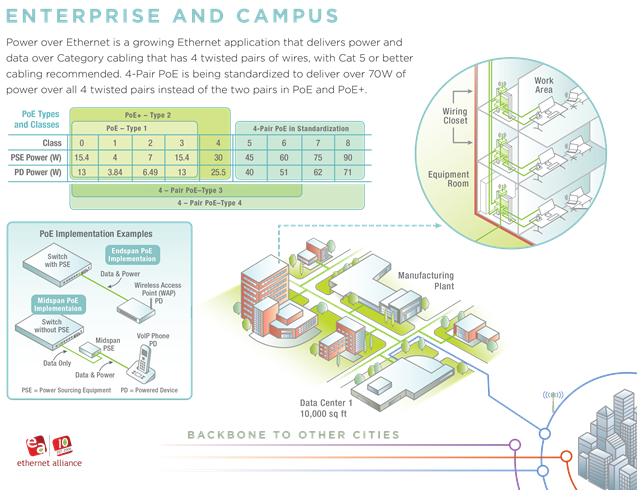PoE Types: What They Mean and How They’re Used
Serving two purposes with one cable: That's what Power over Ethernet (PoE) can do. This technology allows network cables to not only carry data, but also deliver electrical power to networked, IP-enabled devices. Before PoE, two connections (an electrical connection and a network/data connection) would have been required in order to join devices like IP cameras to the network. PoE combines these two into a single network cable.
PoE can enable fast installation and deployment, lower operating costs and maximum reliability for today's enterprise networks. As PoE changes to meet growing technology and application requirements, it is being classified by classes. PoE devices, on the other hand, are categorized by type depending on their power requirements. The difference between PoE "types" and "classes" can sometimes cause confusion when talking about PoE applications and capabilities.
IEEE PoE standards provide for signaling between the power sourcing equipment (PSE) and powered device (PD). PSEs are devices (such as switches) that provide power on the network cable. PDs are the devices powered by a PSE: wireless access points, IP surveillance cameras, VoIP phones, etc.
In this blog, we offer a breakdown of the four PoE types - Type 1, Type 2, Type 3 and Type 4 - and where they're used, along with other terms used to describe them. The terms Belden prefers to use are identified in bold.
Type 1
- Also known as: PoE, 2-pair PoE
- Related standard: IEEE 802.3af
- Maximum power to port: 15.4W
PoE Type 1 utilizes two pairs to connect many types of lower-powered devices to the network. Based on the initial IEEE 802.3af-2003 standard, it provides up to 15.4W of DC power to each PoE port (up to 12.95W of power for each device).
PoE Type 1 can support devices such as VoIP phones, sensors/meters, wireless access points with two antennas and simple, static surveillance cameras that don’t pan, tilt or zoom.
Type 2
- Also known as: PoE+, PoE Plus
- Related standard: IEEE 802.3at
- Maximum power to port: 30W
Higher-powered devices are connected to the network using PoE Type 2, based on the IEEE 802.3at-2009 standard. It is backward compatible (meaning that it can also support the types of devices typically supported by PoE Type 1), and provides 30W of DC power to each PoE port (up to 25.5W of power for each device). PoE Type 2 can support devices such as more complex surveillance cameras that pan, tilt or zoom, as well as wireless access points with six antennas, LCD displays, biometric sensors and tablets.

Photo Credit: Ethernet Alliance
Type 3
- Also known as: 4-pair PoE, 4P PoE, PoE++, UPOE
- Related standard: IEEE 802.3bt
- Maximum power to port: 60W
PoE Type 3 uses all four pairs in a copper cable. Currently in development with IEEE 802.3bt Type 3 Work Group, it is projected to be ratified in early 2017. It provides 60W of DC power to each PoE port (up to 51W of power for each device). PoE Type 3 can support devices such as videoconferencing system components and building management devices.
Type 4
- Also known as: higher-power PoE
- Related standard: IEEE 802.3bt
- Maximum power to port: 100W
Growing power requirements of network devices are pushing the need for higher power delivered through network cabling - which is where PoE Type 4 comes into play. It provides up to 100W of DC power to each PoE port (up to 71W of power for each device). PoE Type 4 can support devices such as laptops and TVs. The standard is currently under development, and scheduled to be ratified in 2017.
Is your infrastructure ready to support 4-pair PoE and the higher power it can produce? Make sure to watch our recent webinar on Power over Ethernet to learn more about the real-world implications of deploying higher-wattage PoE on twisted-pair cabling.
